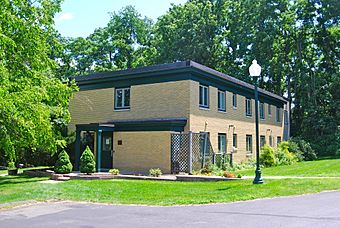Nut Grove facts for kids
Quick facts for kids |
|
|
Nut Grove
|
|

North elevation and east profile, 2011
|
|
| Location | Albany, NY |
|---|---|
| Area | 8 acres (3.2 ha) |
| Built | 1845 |
| Architect | Alexander Jackson Davis |
| Architectural style | Greek Revival |
| NRHP reference No. | 74001215 |
| Added to NRHP | July 30, 1974 |
Nut Grove, also known as the William Walsh House, is a historic building in Albany, United States. It was built in 1845 and designed by a famous architect named Alexander Jackson Davis. The building is made of brick and shows the Greek Revival style. In 1974, it was added to the National Register of Historic Places, which means it's an important historical site.
Nut Grove is special because it's the only house Davis designed in the Greek Revival style in the Hudson Valley. It's also a rare example of a "Grecian country house." Over the years, the building was changed to be used as a hospital. Today, it's part of a care center and is known as the Reilly House. Even though some of its original decorations are gone, it still looks much like it did when it was first built.
Contents
Exploring Nut Grove's Design
The Nut Grove building is located on a large property that belongs to the Addictions Care Center of Albany (ACCA). This property is about 8 acres big. The building is surrounded by grassy areas and some old trees. Nearby, you can find other modern buildings and a parking lot. There's also a peaceful meditation garden and a small gazebo.
What Nut Grove Looks Like
The building is two stories tall and made of yellow brick. It has a flat roof. The long side of the building has five sections, called "bays." There's a small addition on the west side with a sloped roof, which is now the main entrance. Another wooden addition extends from the south side.
The original front of the house was on the east side. It had a long porch, called a "verandah," supported by columns. The windows had special designs above them, like shells or flowers. The first main entrance also had detailed Greek Revival decorations. The current main entrance on the north side has a small porch with a flat roof.
Both the small addition and the main roof have a wide, plain band called a "frieze" and a decorative edge called a "cornice." A newer roof sits on top, with a chimney at one end.
The History of Nut Grove
When Nut Grove was built in 1845, it was outside the city limits of Albany. It was in a town called Bethlehem. William Walsh and his wife were a very wealthy family in the area. They were even connected to the famous writer Henry James.
Architect Alexander Jackson Davis
The Walsh family knew Alexander Jackson Davis, who was a well-known architect. Davis had designed many buildings in the Hudson Valley. One of his famous works is the 1839 Oliver Bronson House in Hudson, which is now a National Historic Landmark.
Davis often designed houses in the Gothic Revival style or a new style called Hudson River Bracketed. These styles were seen as more gentle and natural for country homes. The Greek Revival style, which Nut Grove uses, was often used for bigger public buildings or churches, like Davis's 1835 Dutch Reformed Church in Newburgh.
A Unique "Grecian Country House"
For the Walshes, Davis designed a special "Grecian country house" that looked out over the Hudson River. This style kept the basic shape of Greek Revival homes but added unique decorations. Nut Grove originally had a sloped roof, two back sections, and windows with diamond-shaped glass. There was also a garage and a small house nearby.
Davis designed a few other similar "Grecian country houses" after 1835. A simpler version of this style even appeared in a popular design book from 1850 called The Architecture of Country Houses. Nut Grove is the only one of these special houses that is still standing today.
Changes Over the Years
The Walsh family lived at Nut Grove until William passed away in 1863. His wife later remarried and moved to another house. Her nephew, Dudley Walsh, then took over Nut Grove.
In the 1870s, Dudley Walsh sold the house to Thomas McCarty. McCarty was an immigrant from Ireland who became a very successful brickmaker. He served on Albany's City Council and later became a state assemblyman, helping to make laws for New York State. The city of Albany eventually grew and included the area around Nut Grove. McCarty built a driveway to connect the property to a main street, which is now McCarty Avenue. He also started dividing the large property into smaller pieces of land.
In 1902, Eleanor Spensley bought the house. She had started a hospital in downtown Albany 20 years earlier. Sadly, she passed away two months after buying Nut Grove. The house was then used as a hospital for people needing long-term care until 1973. For the hospital, the roof was raised, and new windows were added.
After the hospital closed, the two back sections of the house were taken down. The building was empty for a while until the Addictions Care Center of Albany bought it. The roof was completely replaced with a flat one, and modern sliding windows were put in. Today, Nut Grove is known as the Reilly House and serves as a supportive living facility.
Images for kids




